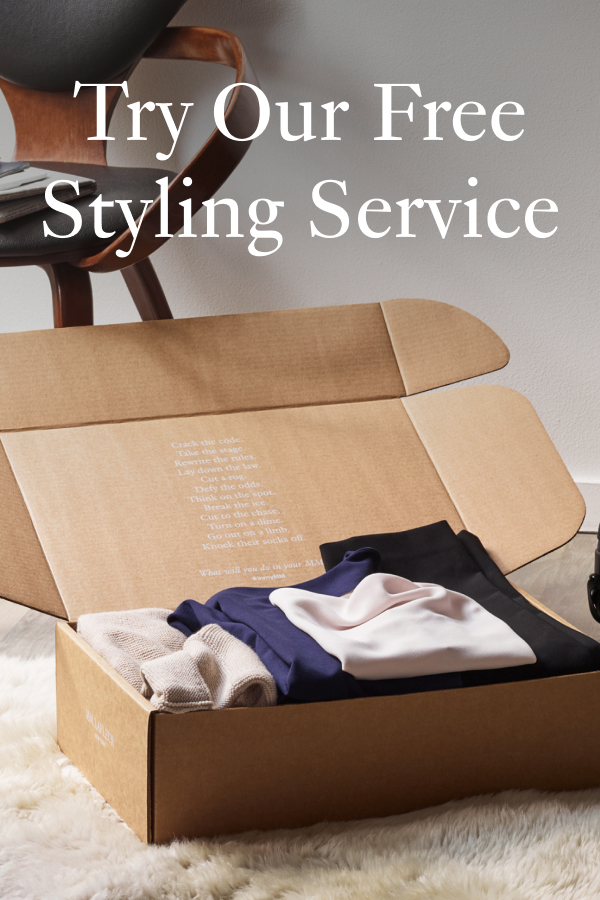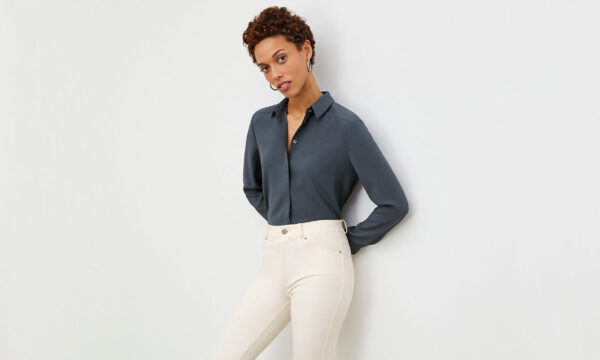
Shop similar to Sarah’s look (left): the Merritt jardigan, Foster pants, and Ella sandals.
Shop similar to Miyako’s look (right): the Moreland jacket, Milo jeans, Grace loafers, and Beebe belt.
Our Founders Explain How Japanese Culture Inspired M.M.’s Design Philosophy
Our co-founders, Sarah and Miyako, credit their Japanese heritage for the unique balance of form and function that defines M.M. clothing.
One thing I’ve always loved about M.M. is that our clothes are more than just clothes. A stretchy-yet-structured jardigan is a jacket, but it could also be the reason you feel comfortable on your morning commute. A dress with lingerie snaps to keep your bra hidden could stop you from fidgeting and help you focus during an important interview. And a machine-washable top might just give you the confidence to order red wine instead of white, because actually, you never really liked riesling.
This marriage of form and function has been a core tenet of M.M. clothing since our founding in 2013. And for our founders, Sarah LaFleur (M.M.’s CEO) and Miyako Nakamura (M.M’s Chief Creative Officer), this philosophy stems directly from the culture and craftsmanship of Japan, where they both grew up.
Want more M Dash?
Sign up for our weekly newsletter.
Thank you!

The Meg top.
“The professional woman wasn’t an afterthought—the goal was to dress her and build a brand around her needs.”
“The concept of M.M. wouldn’t have existed had I not grown up in Japan and seen a market and brands that really focused on dressing busy women,” says Sarah. “The professional woman wasn’t an afterthought—the goal was to dress her and build a brand around her needs. The inspiration for The M Dash was actually Japanese fashion magazines. They were focused on working women’s lives, rather than celebrities or what was happening on the runway.”

Sarah LaFleur’s favorite summer styles: the Liam sweater, Rashmeen dress, and Chadwick sweater.
M.M. clothing is known not only for its elegance and polish, but also for prioritizing ease and functionality. “There’s such a focus on function in Japan that you don’t see in America,” says Sarah. “I think it has a lot to do with the fact that oil, gas, and electricity are cheaper and space is more plentiful in America. Take dry cleaning in New York—it’s not cheap by any means, but it’s cheaper than in Japan, and you get it back in 24 hours. Coming from Japan, I always thought of machine-washability as a priority. I’ve also long subscribed to the idea of investing in versatile, high-quality pieces. That’s probably why our brand resonates so much with people who live in urban dwellings. You don’t have that much space, so you can’t own very much, and so the few things that you own have to be really good.”

Miyako Nakamura’s favorite summer styles: the Annette top, Hyo jacket, and Lasha top.
Sarah and Miyako explain that functionality and efficiency are built into many aspects of Japanese culture. “Tatami living is the idea that your living room, bedroom, playroom, and dining room could all be the same space,” says Sarah. “You put your mattress out at night, and then in the morning, you fold it up and put it away. That’s not how everyone in Japan lives, but that idea of efficiency is deeply ingrained.”
In our clothing, this highly practical approach to design shows up in things like pants with adjustable hems, packable suits that fold up into compact bags, and machine-washable, odor-resistant dresses. These influences also present themselves in the way the M.M. team approaches styling. Every new collection is designed to pair back to items we’ve released in the past, and we even create monthly capsule wardrobes in which every item can be styled many different ways.
“The purpose of our clothes is to celebrate the person wearing them.”
Miyako’s background is in high fashion (before co-founding M.M., she was the head designer for Zac Posen), so transitioning into workwear required a significant mental shift. To make the leap, she turned to a book called How to Wrap Five Eggs: Traditional Japanese Packaging. “As we were developing our very first seven dresses, I wanted things to be extremely streamlined,” says Miyako. “And what the book points out is that the idea of traditional Japanese gift-wrapping is to make the gift shine. I was really inspired by that concept when I was developing our very first seven dresses. The purpose of our clothes is to celebrate the person wearing them.”
Often, this design approach manifests in small details that contribute to the way a garment fits. “The pieces we were designing were so minimalist that every little detail mattered,” explains Miyako. “Take the Aditi dress, for example. “The lines are very simple, but there’s an intentional raise on the neckline that gives you a bit more formality.”
M.M.’s clothing has evolved significantly since those first seven dresses. Relaxing dress codes and the blurring of work and life led us to develop the concept of Power Casual—the clothing equivalent of work-life balance. But through these changes, Miyako’s overall approach to design has stayed consistent. “The way we think about design hasn’t changed,” she says. One thing that’s always set M.M. clothing apart is that we design in 3D. “It connects to the idea of wrapping. Most clothing is designed in two dimensions—front and back—but we think about our pieces more like sculptures that need to be considered from every angle.”
While Japanese design concepts have long been at the core of M.M. clothing, this year’s summer collection included some extra exciting new styles that incorporate Japanese craftsmanship techniques.
“These pieces come from both Japanese culture and Japanese craftsmanship, and the combination of the two makes a very special garment.”
“It’s always been a dream of mine to create pleated pieces for M.M.,” says Miyako. “Our new micro pleat pieces are so special to me, because we got to work with a Japanese company that has incredibly extensive skills (and history) in machine- and hand-pleating. When we received the first swatches, we were like, ‘Oh my gosh, this is the most beautiful thing we have ever seen. We have to make this into a garment.’ Our goal was to design very feminine pieces that don’t overwhelm your frame with the bold shapes that pleats often create. Instead, we wanted to make something soft and whimsical that could really elevate a whole look. And on the functionality side, our pleated garments are made from high-quality polyester, so they’ll never lose their shape.”

The Lasha top and Archie jeans.

The Lasha top and Archie jeans.
We also have Japanese inventions to thank for our soft, lightweight, and long-lasting silk jersey styles. “Have you ever had a silk garment that says it’s washable, but when you put it in the machine, the color fades? That’s what’s different about these pieces,” says Miyako. “We use 100% silk yarn from a Japanese company that’s made some big technological advancements in fibers. Specifically, a yarn manufacturer who specializes in cashmere yarn invented a protein coating that could be applied to silk yarn. This coating gives the silk some of cashmere’s best qualities: durability, body, softness, and breathability. So unlike with other washable silks, our silk jersey garments are made to be washable from the beginning, in the yarn stage—it’s not a treatment they add afterwards. The color doesn’t fade in the machine, and that’s a very rare thing for a silk knit.”

The Leo pullover and Curie pants.
But if we had to choose one thing that epitomizes M.M.’s approach to design and use of Japanese craftsmanship techniques, it would be our Interweave pieces. These items look like classic tweed—which is often stiff and unyielding—but because they’re knitted instead of woven, they’re incredibly lightweight, stretchy, and functional. To create them, we worked with a Japanese company called Yonetomi, which specializes in luxurious tailored tweed knitwear. “The depth of texture that Yonetomi was able to achieve is magical,” says Miyako. “These pieces come from both Japanese culture and Japanese craftsmanship, and the combination of the two makes a very special garment.”

The Figari pullover, Krista skirt, and Yayoi earrings.










